

CGAL 4.2: Package Overview. Algebraic Foundations Michael Hemmer This package defines what algebra means for CGAL, in terms of concepts, classes and functions.
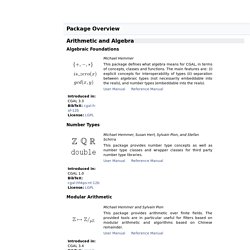
The main features are: (i) explicit concepts for interoperability of types (ii) separation between algebraic types (not necessarily embeddable into the reals), and number types (embeddable into the reals). Number Types Michael Hemmer, Susan Hert, Sylvain Pion, and Stefan Schirra This package provides number type concepts as well as number type classes and wrapper classes for third party number type libraries. Modular Arithmetic Michael Hemmer and Sylvain Pion This package provides arithmetic over finite fields. Polynomial This package introduces a concept for univariate and multivariate polynomials in d variables. Algebraic Kernel Eric Berberich, Michael Hemmer, Michael Kerber, Sylvain Lazard, Luis Peñaranda, and Monique Teillaud. Vectors. This is a vector: A vector has magnitude (how long it is) and direction: The length of the line shows its magnitude and the arrowhead points in the direction.
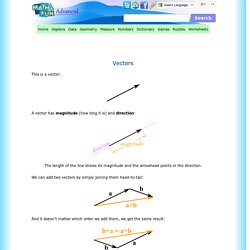
We can add two vectors by simply joining them head-to-tail: And it doesn't matter which order we add them, we get the same result: Example: A plane is flying along, pointing North, but there is a wind coming from the North-West. The two vectors (the velocity caused by the propeller, and the velocity of the wind) result in a slightly slower ground speed heading a little East of North. If you watched the plane from the ground it would seem to be slipping sideways a little. Have you ever seen that happen? Subtracting. Perlin Noise. Many people have used random number generators in their programs to create unpredictability, make the motion and behavior of objects appear more natural, or generate textures.
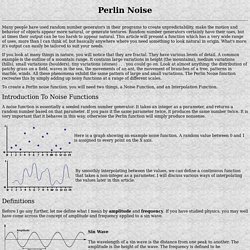
Random number generators certainly have their uses, but at times their output can be too harsh to appear natural. This article will present a function which has a very wide range of uses, more than I can think of, but basically anywhere where you need something to look natural in origin. What's more it's output can easily be tailored to suit your needs. If you look at many things in nature, you will notice that they are fractal. They have various levels of detail. To create a Perlin noise function, you will need two things, a Noise Function, and an Interpolation Function. Introduction To Noise Functions. Simplexnoise.py - battlestar-tux - 3D Top-Down Scrolling Shooter with 4X Elements. Python: Mathematics and Stock/Forex/Futures indicators. Blender Python: Matrix. The code is a little lengthy to post in its entirety, but you can download it here def get_correct_verts(arc_centre, arc_start, arc_end, NUM_VERTS, context):
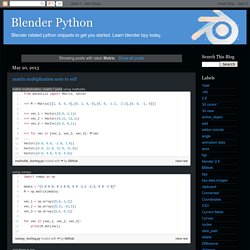
Comprendre les décorateurs Python pas à pas (partie 1) Les fonctions Python sont des objets Pour comprendre les décorateurs, il faut d’abord comprendre que les fonctions sont des objets en Python.
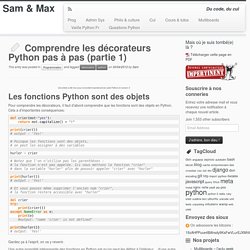
Cela a d’importantes conséquences: def crier(mot="yes"): return mot.capitalize() + "! " print(crier()) # output : 'Yes! ' # Puisque les fonctions sont des objets, # on peut les assigner à des variables hurler = crier # Notez que l'on n’utilise pas les parenthèses : # la fonction n'est pas appelée. Gardez ça à l’esprit, on va y revenir. Une autre propriété intéressante des fonctions en Python est qu’on peut les définir à l’intérieur… d’une autre fonction.
Property Definitions (bpy.props) — Blender 2.70.0 19e627c. This module defines properties to extend blenders internal data, the result of these functions is used to assign properties to classes registered with blender and can’t be used directly.
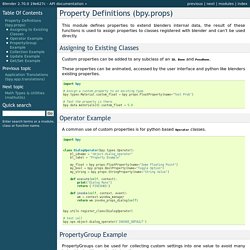
Assigning to Existing Classes Custom properties can be added to any subclass of an ID, Bone and PoseBone. These properties can be animated, accessed by the user interface and python like blenders existing properties. import bpy # Assign a custom property to an existing type.bpy.types.Material.custom_float = bpy.props.FloatProperty(name="Test Prob") # Test the property is there.bpy.data.materials[0].custom_float = 5.0 Operator Example A common use of custom properties is for python based Operator classes.
PropertyGroup Example PropertyGroups can be used for collecting custom settings into one value to avoid many indervidual settings mixed in together. Collection Example Update Example. Blender Python: Sorting. Mostly rewritten, this is currently prototype so clunky/verbose code. but works !
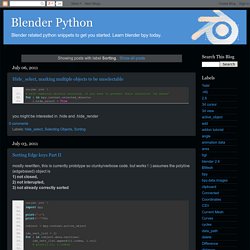
:) assumes the polyline (edgebased) object is 1) not closed, 2) not interupted, 3) not already correctly sorted import bpy print("\n")print("="*50) Property Definitions (bpy.props) — Blender 2.70.0 19e627c. Animation - Convert particle system to animated meshes - Blender Stack Exchange. Current community your communities Sign up or log in to customize your list. more stack exchange communities Stack Exchange sign up log in tour help Blender beta Ask Question Take the 2-minute tour × Blender Stack Exchange is a question and answer site for people who use Blender to create 3D graphics, animations, or games.
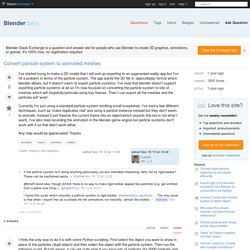
Convert particle system to animated meshes 2 Answers active oldest votes Your Answer Sign up or log in.
Animation node. Python Sort Examples: Sorted List, Dictionary. Built-in Dictionary List Set Tuple 2D Array Bytes Class Console Convert Datetime Def Duplicates Error Fibonacci File Find If Lambda Lower Map Math Namedtuple None Number Re Slice Sort Split String Strip Substring While Sort.
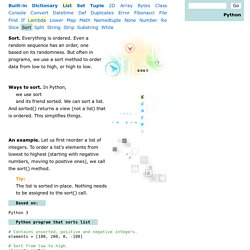
Everything is ordered. Even a random sequence has an order, one based on its randomness. But often in programs, we use a sort method to order data from low to high, or high to low. Searching and Sorting — Problem Solving with Algorithms and Data Structures.